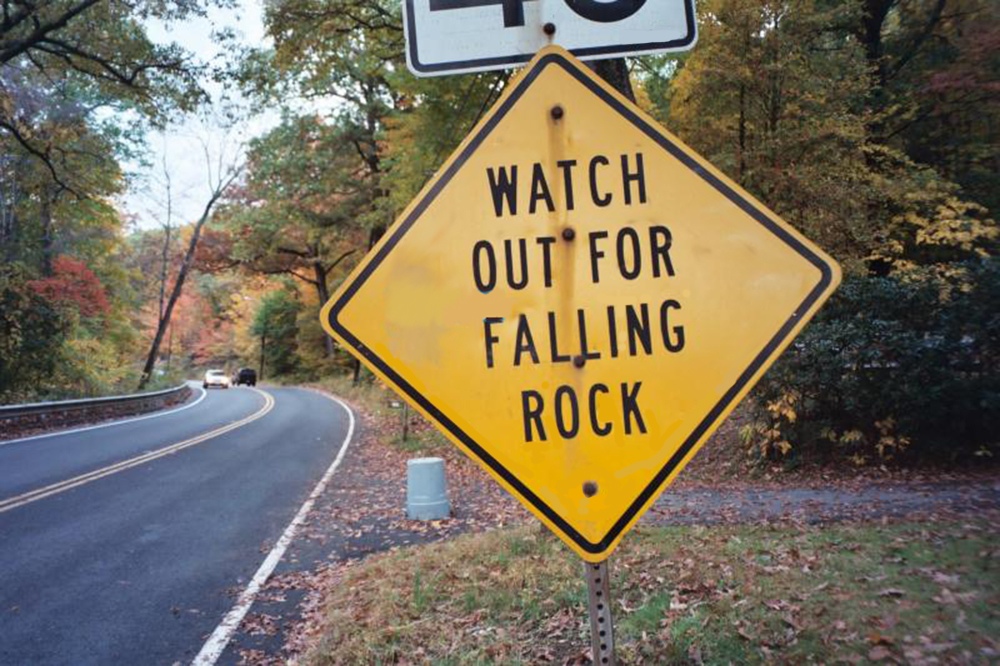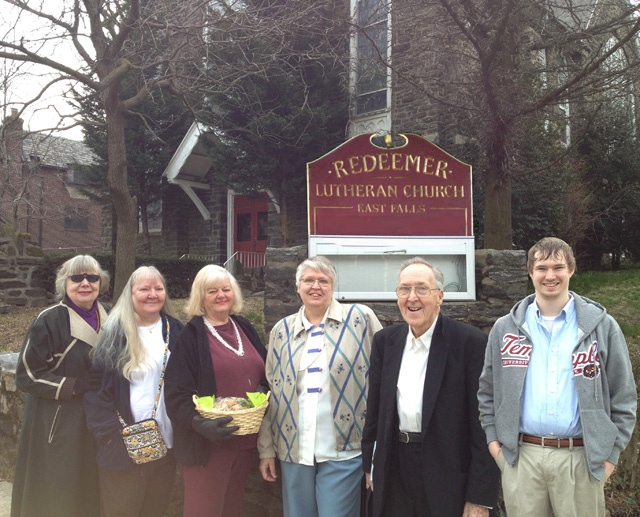Ever pass a highway sign like the one shown here?
This common warning sign has puzzled me since I started driving back in the 60s.
WATCH OUT FOR FALLING ROCK! Thanks for the warning, but give me a clue. What should I do if I look up and see rocks falling from the sky? My car, passengers, and I are already committed to the route, traveling along the narrow, winding and steep road. We are in the danger zone. We can’t afford to take our eyes off the road to look for trouble falling from the sky.
I’ve noticed recent variations— Watch out for FALLEN ROCK, for example. That’s different from FALLING ROCK! What do they mean? How is a driver to know?
This sign is a metaphor for state of the Church and other Faith Communities. There are plenty of people warning us about a troublesome future and very little help offered as we travel at hurtling speeds to get there. It’s especially true for small congregations.
That’s why our small church, Redeemer Lutheran Church in East Falls, Philadelphia, started 2×2 Foundation and this website, 2x2virtualchurch.com.
Many congregations sense that their value to the greater Church is statistical—not missional. As long as money flows toward hierarchy and clergy, all is well.
But without support dollars flowing as they did during the Baby Boom, they might as well post signs by our doors.
Many small congregations are endangered. They have enough resources to exist and serve in their own communities—if they don’t have to spend every dollar on denominational prerequisites. Their most valuable assets—individual resourcefulness, passion for mission, and goodwill—are not measurable by statisticians, but a church with great statistics but which lacks these qualities exists at greater risk!
FACTS:
- Most Christians belong to smaller churches.
- Small churches are still important to mission—local, regional, and national.
- Small churches don’t get much help.
- When regional bodies focus on the fewer, larger congregations they are serving their minority constituency.
Something is wrong with this picture!
The “signs” presented to us who live and work in small faith communities look something like this:
The bracketed threat, by the way, is very real!
What do church leaders mean by “TRANSFORM”?
Ask this question—if you can find a forum within the Church for laity to raise challenging questions! You are likely to get answers like this:
The big question: What does that mean?
The bigger question: HOW?
WATCH OUT FOR FALLING ROCK!
That’s what 2×2 is all about. We want small churches to succeed. We want churches to stay in changing neighborhoods, serving the people that can’t follow the parade to the suburbs. We want to do more than warn people. We want to help them navigate.
We’ve often find the advice of church leaders to be unrealistic.
Every so often a successful preacher is paraded before congregations as an example to follow. Small congregations are supposed to be inspired. But these successes are usually rare exceptions and are probably based on an individual leader’s charisma. This is discouraging. We know we can’t get the same results with part-time and retired pastors—no matter how good they might be.
The same people who put up the road signs also put up roadblocks. We are asked to “TRANSFORM” by doing things the same way!
- Transform, but sink your money into as much pastor as you can afford so there is no money to seek different solutions or outside skills.
- Transform, but hire experts to help you (at considerable cost) who will side with the regional body in their assessment. (That’s where they get referrals!)
- Transform, but rent your unused property assets to regional agencies at a fraction of their market worth.
- Transform, but use only denominationally approved resources.
- Transform, but if there is any expense or risk involved, make sure you get approval — from people who have an interest in preserving your assets for their own benefit.
We at Redeemer faced these common problems.
Although our statistics weren’t much different from dozens of other congregations, our endowment had attracted attention for years and created tension between our congregation and our regional body. After decades of unsuccessful maneuvering, the ELCA just declared us closed, locked us out and grabbed our property and money.
But Redeemer never closed.
Redeemer Church in East Falls without its endowment and property became 2×2 Foundation and kept its ministry going online. After four years, our weekly readership outnumbers the attendance of any other church in the regional body that no longer recognizes us.
Without our own sanctuary, members spearheaded our Ambassadors program that took us to 80 congregations in our five-county area. We visited—worshiping and observing. We talked to members, studied websites and read newsletters. A beautiful picture emerged, but one that needs to develop self-worth and confidence. We saw churches that needed to focus on what they CAN do (which is a lot) and stop trying to live up to the expectations of larger churches.
Our experience was recorded online, but it also sparked a book and study guide—Undercover Bishop.
Another resource that grew from our experience talking with struggling churches is Mission Inspiration, a slideshow that congregations can use to spark discussion about where their individual missions fit into the whole mission of the church.
 I’m Judy Gotwald. I’m not a theologian. I haven’t spent four years in seminary, although I’ve worked for seminaries. I grew up in a large family of preachers, preachers’ wives, missionaries, and seminary professors from several generations and denominations. I spent 50 years attending or teaching Sunday School and VBS, ten years planning worship when our congregation had no pastor, and countless years serving on church councils and numerous volunteer roles. I sang in the choir, I taught music camp and worked with children’s choirs. I spent summers working and attending church camp. I collated and folded bulletins and newsletters. I shoveled snow and mopped floors. I cooked lots of soup for fellowship hours.
I’m Judy Gotwald. I’m not a theologian. I haven’t spent four years in seminary, although I’ve worked for seminaries. I grew up in a large family of preachers, preachers’ wives, missionaries, and seminary professors from several generations and denominations. I spent 50 years attending or teaching Sunday School and VBS, ten years planning worship when our congregation had no pastor, and countless years serving on church councils and numerous volunteer roles. I sang in the choir, I taught music camp and worked with children’s choirs. I spent summers working and attending church camp. I collated and folded bulletins and newsletters. I shoveled snow and mopped floors. I cooked lots of soup for fellowship hours.
As a professional writer and graphic designer I have worked in the field of religious publishing for 35 years, where I typeset, copyedited and even wrote curriculum material—again for different denominations. I helped a missionary develop resources for taking the Gospel to Tibet. I worked closely with other missionary organizations and served on the board of a Lutheran service agency. Most recently, when our small church came into conflict with the ELCA, I was one of two members named in the law suits that lasted six years. You might say I graduated from the “seminary of hard knocks”!
I saw enormous potential for the church when the internet and blogging came along and that spurred me to study a field related to mine—marketing. I had often worked with public relations specialists and development offices, but never studied the field. For the last four years, I’ve not only studied, but I put what I’ve learned to work on 2×2. Marketing is evangelism, and blogging is the tool Paul and Silas could only wish for. We will continue to test new evangelism strategies on 2×2—and we’ll be glad to teach them to other churches.
2×2 started as a blog managed by one but now involves other Redeemer members as it becomes more and more complex. I do most of the writing, but the ideas I express are discussed with the rest of our congregation every Sunday morning and often during the week. Others in our faith community offer ideas and links to share. Our younger members—the ones who never learned cursive writing but are whizzes at the keyboard, help with technical issues.
Our experience suggests that the future of the church lies in the empowerment and increased involvement of lay people—not as token assistants to clergy but as capable and responsible, thinking and acting Christians. With the efforts of lay leaders, God will grow the church of the future, just like God grew the church of the past—2×2.
In a nutshell, 2×2’s mission is small church ministry. We provide resources and ideas to small congregations that can used by laity who may not have a pastor, music director and organist, or education director to help. We hope our content is helpful to transformationally minded clergy, too!
We also provide commentary on the state of the Church to stimulate creative mission thinking.
We are serious about small church ministry.







